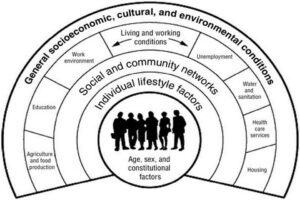Healthy city, healthy life
Share Line
Twitter: Healthy city, healthy life – how can a health in all policies approach at a local level improve population health? Read @LongITools latest blog to find out! #exposome
How can a health in all policies approach at a local level improve population health?
Health development and policies that look to improve the health and wellbeing of people are constructed at different levels of government. They can be part of complex health systems with tensions in direction at those different levels. Over the past decade, focus has increasingly shifted towards the wider/social determinants of health. This approach has been around for a while within public health, but it has grown in importance as health inequalities have widened and life expectancy has stalled.

Source: Dahlgren and Whitehead (1991)
The approach looks to investigate those wider, social-economic factors that influence a person, family or community’s health. With this in mind, policymakers are increasingly looking to tackle these determinants. One approach where they are doing this is Health in All Policies (HiAP). In 2013, at the 8th Global Conference on Health Protection, governments endorsed the Helsinki statement:
“Health in All Policies is an approach to public policies across sectors that systematically takes into account the health implications of decisions, seeks synergies, and avoids harmful health impacts in order to improve population health and health equity.”[1]
At the European Union (EU) level, HiAP has been adopted as an approach, heavily pursued by the Finnish government. The aim was to strengthen the implementation of Article 152 of the Amsterdam Treaty (and corresponding Article 168 of the Lisbon Treaty) in European policy development within the EU.[2] This can play an important role in improving the health of populations across Europe.
However, it is just as important to ensure HiAP at a local level. Local levels of government are vital anchors in improving health within communities and can take a more targeted approach than national governments through local intelligence and relationships. This has been highlighted by the Covid-19 pandemic with local responses and local track and trace systems proving effective at keeping the virus under control.
A HiAP approach can therefore have profound benefits for local places, by ensuring that public health is embedded across the different roles and functions that local governments are responsible for. It also provides the opportunity for new science and research to embed itself into policymaking. As emerging evidence for improving health comes to light, a HiAP approach will enable policy interventions to have a wider reach than just in health systems and help tackle those social determinants of health.
Local places have already taken the lead in using HiAP to progress a healthy planet and healthy people agenda, progress the Sustainable Development Goals (SDGs) and improve their place. The C40 Cities global partnership is working together for a healthier and more sustainable future. The World Health Organisation (WHO) European Healthy Cities Network has brought together some 100 flagship European cities and around 30 national networks to put health high on the agenda. Local places such as New York (USA), Bristol (UK), Stockholm (Sweden) and Barcelona (Spain)[3] have committed to progressing the SDGs locally and monitoring their progress.
HiAP can have a powerful impact at a local level. The above cities are demonstrating innovative ways local places can take a HiAP approach, such as by adding health to their sustainability agenda (SDGs) or working alongside the WHO to develop a healthy city. New science and research can help progress this further and keep local places at the forefront of emerging evidence and policy options to improve population health. The LongITools consortium is a network of universities, research organisations and SMEs from around Europe, located in cities and places that are already taking the lead in HIAP at a local level. Examples include:
Bristol have taken a city approach to long-term policymaking with a 2050 One City Plan to make Bristol a fair, healthy and sustainable place. As local adopters of the SDGs, health is a prominent part of their long-term plans.[4]
Oulu – The University of Oulu, Business Oulu and OuluHealth are the three strategic pillars of the health and sustainable goals of the city of Oulu and the Northern Ostrobothnia region. Oulu aims to become carbon neutral by 2040.[5] Local neighbour Ii has been described as potentially ‘the greenest town in Europe’.[6]
Doncaster has set up a Climate and Bio-Diversity Commission that will recommend how Doncaster can become carbon neutral, with public health at its heart.
Rotterdam is a member of phase VI of the WHO Healthy Cities Network and an ‘innovator’ city in the C40 Cities network.[7]
This focus on local places will drive LongITools’ approach to ensuring its research can be translated into policymaking. Through working with policymakers in local places, the emerging scientific evidence coming from LongITools will help provide new HiAP options to improve local population health. New policy options are a key output of the project, and this close relationship with local places can ensure they are robust and fit for local places to implement. A network of LongITools cities is a real possibility. Never has it become more important to incorporate health into local policymaking to make sure communities across Europe can live healthy lives.
References
[1] World Health Organization, Finland Ministry of Social Affairs and Health. Health in all policies: Helsinki statement. Framework for country action. World Health Organization; 2014.
[2] Eeva Ollila. ‘Health in All Policies: From rhetoric to action’. Scandinavian Journal of Public Health (2011). 39(6): 11-12.
[3] https://sdg.iisd.org/news/local-governments-commit-to-sdg-reporting-in-vlr-declaration/
[4] http://www.bristol.ac.uk/media-library/sites/cabot-institute-2018/documents/BRISTOL%20AND%20THE%20SDGs.pdf
[5] https://www.ouka.fi/oulu/ymparisto-ja-luonto/ymparistoohjelma
[6] https://www.youtube.com/watch?v=5S-2DBwqmuw
[7] https://www.euro.who.int/en/health-topics/environment-and-health/urban-health/who-european-healthy-cities-network/membership/list-of-phase-vi-healthy-cities; https://www.c40.org/cities/rotterdam